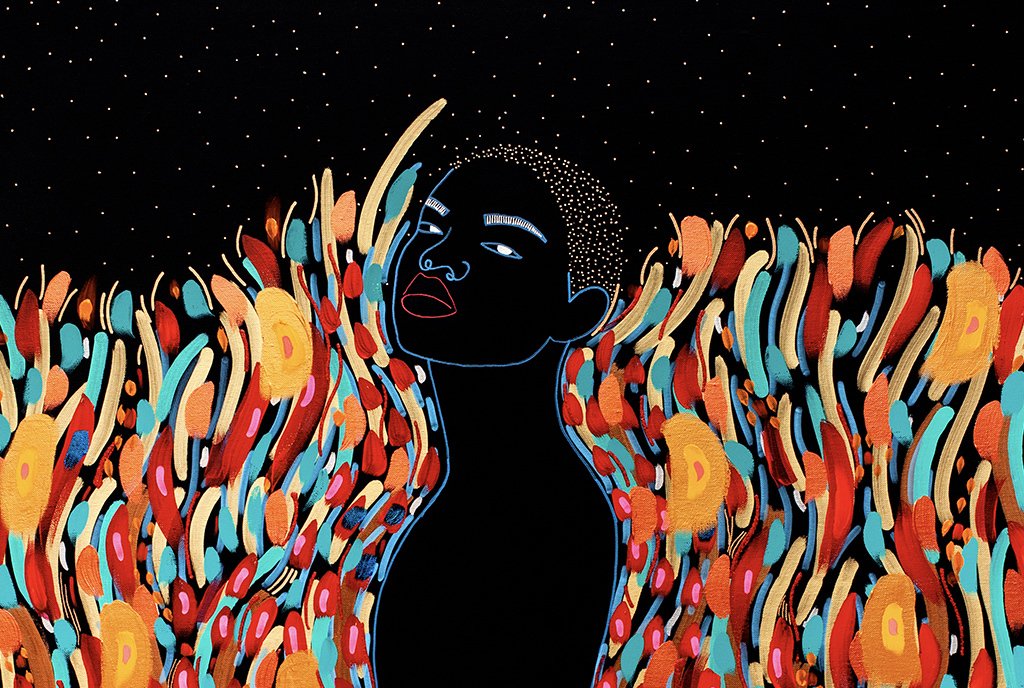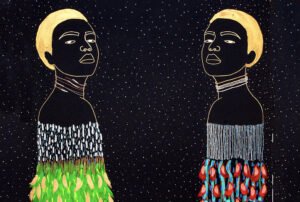
Editors’ note: This piece is from Nonprofit Quarterly Magazine’s spring 2024 issue, “‘Stop Drowning Us, and Stop Making Us Disappear’: A Critical Report on the State of Black Woman Leadership.”
The very presence of Black women leaders in the workforce is fugitive. We were never intended to function in it beyond our historically designated roles in “agriculture and domestic service.”1 Black women are systematically suppressed within the labor economy through chronic underemployment and an enduring exclusion from “employer-provided retirement plans, health insurance, paid sick and maternity leave…[and] subsidized child and elder care.”2 We are overwhelmingly present in low-wage, inflexible service work, but there is a small contingent of Black women who have somehow transgressed this universal sentencing to unprotected, low-wage oblivion, and have beaten the odds only to find that the reward for their efforts is an impossible dilemma—a choice to drown or to disappear. In my essay collection on the interiority of Black women, The Black Subaltern: An Intimate Witnessing, I write, “If we allow ourselves to be as Black as we are, they will drown us in the darkness. If we refuse to be as Black as we are, they will make us disappear.”3
A Black Woman Leader Drowns
Any Black woman deemed to be an Angry Black Woman will quickly find herself shunned for this fatal flaw, castigated for the way it impacts the entitled contentment of her environment and the people in it.
In predominantly White spaces, a Black woman is expected to code-switch, mimic White culture, and either explicitly or implicitly affirm harmful propaganda about Black people, in order to signal that she can be trusted by the establishment. Beyond that, she is also expected to turn a blind eye to the presence and implications of institutional racism and its impact on herself and other Black people, both within the organization and without. If she is willing to do these things, she will be rewarded with both upward mobility and proximity to the gatekeepers that hold power within that ecosystem. Take Candace Owens, who in 2007, with the support of the NAACP, sued and settled with the Stamford Board of Education for failing to protect her from hate crimes motivated by racism.4 By 2019, and now functioning as a leading voice within the Republican Party, not only did Owens denounce the NAACP as “one of the worst groups for Black people”5 but also—in 2020—insisted that Ahmaud Arbery’s death was unrelated to his race, even after the Georgia Bureau of Investigation reported that his killer referred to him as a “fucking n—r” before killing him.6 Her willful and irrational denial of overt White supremacy—even in instances in which it is categorically undeniable—demonstrates, if on a farcical level, a knowing determination to barter race blindness and denialism for continued preservation of her transgressive leadership as a Black woman within a White establishment politic.
Beyond such absurdly problematic Republican party pandering, Black women who lead across industrial structures are routinely found participating in the same type of exchange. If, however, a Black woman in leadership decides that the price for the goodwill of the establishment is too high and too cutting of a self-betrayal, she will quickly find herself cast in the role of any number of prejudicial tropes—and none so pervasive as the “Angry Black Woman.” In 2022, the Harvard Business Review published an article about the workforce politics that reinforce the lore of the Angry Black Woman, finding that the imagery dates back to the era of enslavement—which makes sense, since the trope justifies the belief that a Black woman’s anger results from an innate personality defect rather than from a harmful situation.7
An Angry Black Woman must be put back in her place—stripped of her dreams and her dignity, and left on her own. She will drown, because nobody’s coming to save her.
Any Black woman deemed to be an Angry Black Woman will quickly find herself shunned for this fatal flaw, castigated for the way it impacts the entitled contentment of her environment and the people in it, incessantly denied the support she deserves to mitigate the issues she is contending with, and left enduringly alone, because she is intolerable and understood to be exiled to an isolation of her own making. Even the very few who can see that she is being framed by this mythology, and accordingly sympathize with her condition, will continue to avoid her, because her social standing is contagious and dangerous for their own sociopolitical situating within the establishment. So, the Black woman who leads in service of Black people, whose circumstances are in fact deeply upsetting, will invariably find herself drowning in an ocean of White discontent—and even those for whom she is sacrificing herself will not come to save her, because they know her fate is certain, and they are fighting to survive.
This drowning of Black women leaders isn’t exclusive to organizations led by White figureheads but—owing to the pervasive power of Whiteness in its underpinning, resourcing, and defining of the culture of the industrial landscape—is also present even in organizations with Black women at the helm. In the case of Black Girls Code, CEO Kimberly Bryant, who founded the organization in 2011, was abruptly denied access to her email in December 2021 and later learned that she had been indefinitely suspended by her board of directors—after her company had been valued at $30 million in philanthropic funding.8 Accused of creating a toxic work environment—no doubt a thinly veiled nod to the widely acceptable typecasting of the Angry Black Woman—Bryant (by her own account) was removed “without cause or an opportunity to participate in a vote…[and denied] severance, healthcare assistance, or a vacation payout,…which she is entitled to by law in California.”9 Similarly, in 2019, Kim R. Ford was announced as the new president and CEO of Martha’s Table, following her service to “President Obama’s Administration, where she helped lead the implementation of the American Recovery and Reinvestment Act, distributing more than $350 billion in recovery funds to spur economic growth.”10 A short three years later, Ford unexpectedly resigned, publishing the following statement:
Throughout my tenure, the board has been extremely abusive towards me…. They have publicly threatened and humiliated me on many occasions, manipulated the team, sabotaged the organization and spoken very negatively about the community. I was told that the behaviors would be addressed, people would be held accountable and things would get better. Instead, the behaviors got worse. I asked for help repeatedly. I was even uncharacteristically vulnerable in telling them several times about how much their treatment had harmed my mental, emotional and physical well-being, and I even gave specific examples of the impact—but that was ignored.11
It is very easy to malign and mistreat an Angry Black Woman in a position of power—even if that categorization is based solely on imagined characterizations and conjectures that are reinforced through cultural media and the vagaries of modern public discourse. An Angry Black Woman must be put back in her place—stripped of her dreams and her dignity, and left on her own. She will drown, because nobody’s coming to save her.
A Black Woman Leader Disappears
In The Black Subaltern: An Intimate Witnessing, I explain the theory of disappearance to signify how the Black female internal self can be absorbed into the system to which she is attempting to gain entrance—in this case, the workforce. If a Black woman leader decides to play the game of racial self-denial in order to ascend institutional structures, my theory holds that she will be unable to recover what she has hidden of herself and will, in fact, be lost.
Sign up for our free newsletters
Subscribe to NPQ's newsletters to have our top stories delivered directly to your inbox.
By signing up, you agree to our privacy policy and terms of use, and to receive messages from NPQ and our partners.
In the nonprofit-industrial complex, this typically looks like Black female leaders adopting what Makeba Lavan refers to as a belief in “apolitical multiculturalism,” or the White ventriloquism of non-White people who refuse to attend to race.12 In this way, Black women who disappear lead from a hollow place, parroting what they have observed to be the acceptable rationalizing language of the establishment over and against the interests of their people whenever necessary.
Many Black women in positions of leadership earnestly believe that they cannot afford the luxury of a more integral moral ecology because they are being made to choose between their livelihoods and their ideals. Many also feel that rather than an act of self-betrayal, it is an act of resigned fatalism—one that simply acknowledges that the fate of Black women will never change, and thus self-sacrifice is as meaningless as it is costly and therefore not worth the bargain. They have observed the many Black women champions who have carried generations of racial turmoil and harm on their backs only to be put out to pasture and labeled “indefensible,” and they have decided instead to survive an ugly system the only way they see possible: in hiding.
It would be a mistake to consider this choice to be tensionless; nevertheless, it is a form of surrender. There are yet other Black women leaders who reason that the pace of change, although slow, is sure, and rationalize their assimilation as strategically beneficial in the long run. Some sincerely believe that admittance to influential rooms is a signal that sometime in the illusive future they will earn acceptance and the power to pull others up as they climb.
Former First Lady Michelle Obama was widely criticized for her exclusively White-adjacent hairstyles while in the White House; but following her tenure, she explained that she believed “America wasn’t ready to accept her natural hair…[and] she didn’t want the focus to be on trivializing her hair but [rather] on the work that needed to be done for the American people.”13 Now free of the weight of the Oval Office, she has begun experimenting with wearing her hair as it naturally occurs. Only the former First Lady would be able to verify whether the choice to disguise herself in White-adjacent hair for eight years felt like hiding and whether her current shift in hairstyling is in fact an expression of her personal autonomy and not simply a new type of ventriloquism in search of self-recovery and approval. None of us can say. What we do know is that a Black woman in leadership who has refused to drown will invariably notice that all of the concessions she assents to amount to her disappearance.
These deeply painful losses—of dreams and promise and life itself…are telling us a valuable truth about what it costs to be a Black woman who leads. It is a truth we have been ignoring for a very long time, and a truth whose time has come.
Fixing Things for Black Women Leaders
The question remains: What would make leadership better for Black women? Stop drowning us, and stop making us disappear. The Angry Black Woman is a dangerous fiction, and once applied, we are no longer seen, heard, or attended to. Black women cannot stop its application, but someone should. When forced to choose between self and survival, even if only for the benefit of all of the people who depend on us, many of us will elect to survive. We cannot reorder the conditions of the labor-industrial complex, or, frankly, any other establishment, to make ourselves acceptable as we are—that is not our work. But if that work continues to be neglected, we will continue to lose our hair, our minds, our souls, our bodies, our voices, and our futures—and oh what a tragedy that would be.
After I had finished writing this article, Dr. Claudine Gay, the first Black woman president of Harvard University, also became the first Harvard president to serve a term of only six months and two days.14 In a guest essay published in the New York Times, Gay explained her departure, saying that she “fell into a well-laid trap.”15 Just days later, Dr. Antoinette Candia-Bailey, the vice president for student affairs at the historically Black Lincoln University, died by suicide,16 sparking widespread outrage and a range of conversations about the impossible task of enduring in a position of leadership within the academy. These deeply painful losses—of dreams and promise and life itself—both within the predominantly White community and the historically Black community, are telling us a valuable truth about what it costs to be a Black woman who leads. It is a truth we have been ignoring for a very long time, and a truth whose time has come.
Notes
- Nina Banks, “Black women’s labor market history reveals deep-seated race and gender discrimination,” Working Economics Blog, Economic Policy Institute, February 19, 2019, epi.org/blog/black-womens-labor-market-history-reveals-deep-seated-race-and-gender-discrimination/.
- Ibid.
- Shauna Knox, The Black Subaltern: An Intimate Witnessing (New York: Routledge, 2022),
- J. O’Connell, “Schools pay $37,500 to Owens family,” The Hour, January 29, 2008, www.thehour.com/norwalk/article/Schools-pay-37-500-to-Owens-family-8240741.php.
- Blue Telusma, “Candace Owens claims she’s never had ‘race issues,’ but apparently has selective amnesia,” TheGrio, November 14, 2019, com/2019/11/14/candace-owens-claims-shes-never-had-race-issues-but-apparently-has-selective-amnesia/.
- Kali Holloway, “Candace Owens Is a Willing Tool of Republican Racists,” Daily Beast, last modified October 11, 2020, thedailybeast.com/candace-owens-is-a-willing-tool-of-republican-racists.
- Daphna Motro et , “The ‘Angry Black Woman’ Stereotype at Work,” Harvard Business Review, January 31, 2022, hbr.org/2022/01/the-angry-black-woman-stereotype-at-work.
- Natasha Mascarenhas and Dominic-Madori Davis, “Black Girls Code founder Kimberly Bryant has been fired by her board,” TechCrunch, August 17, 2022, com/2022/08/17/black-girls-code-founder-kimberly-bryant-has-been-fired-by-her-board/.
- Ibid.
- Martha’s Table, “Martha’s Table Announces Kim Ford as New President & CEO,” news release, March 18, 2019, www.prnewswire.com/news-releases/marthas-table-announces-kim-r-ford-as-new-presidentceo-300814027.html.
- James Wright , “Martha’s Table CEO Kim Ford Makes Sudden Departure,” Washington Informer, February 9, 2022, www.washingtoninformer.com/marthas-table-ceo-kim-ford-makes-sudden-departure/.
- See John Blake, “When hope becomes a four-letter word: What’s missing from today’s TV shows that deal with race,” CBS News Detroit, July 17, 2023, cbsnews.com/detroit/news/when-hope-becomes-a-four-letter-word-whats-missing-from-todays-tv-shows-that-deal-with-race/.
- Jailynn Taylor, “Breaking Barriers with Braids: Michelle Obama’s Natural Hair Evolution with Hairstylist Njeri Radway,” Essence, last modified February 22, 2023, essence.com/hair/michelle-obamas-natural-hair-evolution-with-hairstylist-njeri-radway/.
- Claudine Gay, “Claudine Gay: What Just Happened at Harvard Is Bigger Than Me,” New York Times, January 3, 2024, nytimes.com/2024/01/03/opinion/claudine-gay-harvard-president.html.
- Ibid.
- Daryn O’Neal, “Lincoln University Administrator’s Suicide Sparks Conversation About Mental Health,” The Hilltop, January 29, 2024, com/2024/01/29/lincoln-university-administrators-suicide-sparks-conversation-about-mental-health/.










